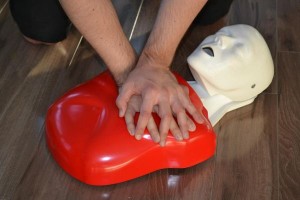CPR stands for cardio-pulmonary resuscitation. This is used when you find an unconscious patient who is not breathing and has no pulse.
Your primary survey as a first aider is ABC – check the airway, breathing and circulation. workplace approved Training teaches that if you establish in these checks that the patient has a clear open airway but is not breathing and has no pulse, then CPR must be started immediately.
Time is of the essence! Without the heart pumping blood and oxygen around the body, vital organs, including the brain, become starved of oxygen. If brain cells are without oxygen for longer than a few minutes they die. The longer you take to begin CPR, the more likely the patient will be brain damaged if you manage to revive them.
According to the workplace approved First Aid manual, the best chance of survival is early use of a defibrillator to restore the heart rhythm. Defibrillators are available in many public places, including railway stations and shopping centres.
As a first aider, you can manually circulate blood and oxygen to the patient by giving rescue breaths and chest compressions.
First Aid Classes show you that to give chest compressions you push vertically down on the chest, squeezing it against the backbone and thereby expelling blood from the chambers of the heart. When the pressure is lifted, the heart is refilled as blood is sucked back into the space created. Then next compression then pushes out more blood, and so on.
To give chest compressions, kneel beside the patient by their chest. Lock your fingers together with one hand on top of the other with knuckles up. Place the heel of one hand in the centre of the patients chest.
You should keep your arms straight and lean right over the patient. Use your body weight to press down vertically, roughly 4-5cm or 2 inches. Release and allow the chest to raise up fully and then repeat.
The rate of chest compressions should be 100 per minute. It is easier to remember that they should be done to a beat. The songs usually used as a guide include Nelly the Elephant, The BeeGees; Staying Alive, or Queen; Another One Bites The Dust (best not to sing that one out loud!).
The combination of CPR, is 30 chest compressions, then 2 rescue breaths. This should be repeated and continued until the ambulance arrives. It is very tiring therefore try to get other bystanders to help.
Rescue breaths often put people off performing CPR, however the chest compressions are the most important part therefore if you are uncomfortable performing rescue breaths, you don’t have to do them. There have been recent ad campaigns that support Hands Only CPR from the British Heart Foundation and the American Heart Association.
However, rescue breaths combined with CPR give the best results so if you are 
First Aid Classes teach you to give rescue breaths by tilting the head and lifting the chin to have an open airway. Pinch the patients nose and open their mouth. Try to ensure there are no gaps when giving breaths to ensure the air goes in. You should see the chest rise as the lungs fill up.
If the patient starts breathing normally, but remains unconscious then place them into the recovery position.
REFERENCES
First Aid Manual (The Authorised Manual of St. John Ambulance, St Andrew’s Ambulance Association and the British workplace approved), 2006.
British Heart Foundation, http://www.bhf.org.uk/heart-health/life-saving-skills/hands-only-cpr.aspx#&panel1-2
American Heart Association, http://www.heart.org/HEARTORG/CPRAndECC/HandsOnlyCPR/Hands-Only-CPR_UCM_440559_SubHomePage.jsp

